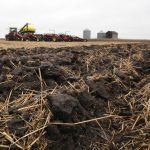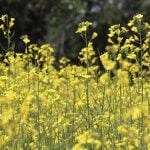As dry conditions persist throughout western Canada’s irrigated regions, research is harnessing the power of remote sensing and computing to help farmers better manage two precious resources: water and time.
 Justin Gibson, Ph.D
Justin Gibson, Ph.D
Justin Gibson is the senior manager, computational agronomy for Lindsay Corporation, based in Omaha, Nebraska. The company offers solutions that allow farmers to remotely manage their irrigation systems from their computer, tablet or smartphone.
“We know these systems can increase irrigation efficiency and return value to growers both in terms of energy and water savings and increased yields,” he says. “Despite this, not all farmers take advantage of these tools because they take some time to set up and continued effort after that to carry out the system’s recommendations.”
Together with his colleague, data scientist Mitch Maguire, Gibson set out to see if they could harness the timely and detailed information of field conditions available through remote sensing satellites to make the tools easier to adopt and use.
“We offer an irrigation recommendation tool called FieldNET Advisor™ that tracks weather conditions, irrigation application and crop development,” Gibson says. “FieldNET Advisor tracks inputs and outputs in a field and predicts how soil moisture changes over time.”
Gibson and Maguire zeroed in on where farmers spent the most time: entering crop type, variety and planting data for every field. Drawing on its established database, the system can then simulate the field and estimate evapotranspiration, that is, how much water is being lost to the atmosphere from the soil and the crop itself.
 Mitch Maguire, Data Scientist
Mitch Maguire, Data Scientist
Tapping satellite remote sensing data offered a way to reduce or eliminate this time-consuming step, while improving the performance of the system itself.
“Satellite imagery is often freely available, in the public domain, and best of all, updated throughout the growing season,” says Maguire. “If we could develop an effective algorithm, it would eliminate a tedious task for the farmer while delivering recommendations based on near real-time data.”
That algorithm was put to the test with field trials in 2023. To get a picture from a wide range of crops, climate and soil conditions, the trials were held in Washington, Nebraska, Wisconsin and Georgia within corn, soybean, potato and cotton fields.
To assess the accuracy of the new system, the research team set up in-field weather stations and soil monitoring probes to collect information on rainfall, evapotranspiration, canopy development and soil moisture. Then they compared the performance of the current version of FieldNET Advisor with the same system running with the new remote sensing algorithm.
“We found the new system reduced the evapotranspiration error by 45 per cent. It was actually more accurate.” Maguire said. “In practical terms, for farmers, this means a high degree of confidence in the system’s recommendations.”
For Gibson, the hope is these new enhancements to FieldNET Advisor may help shift farmers off the fence and encourage them to adopt this water management tool.
“Water is the most important crop nutrient and the one we have the least control over,” he said. “But our tools are getting better and better to get the most out of the resource while saving time and input dollars.”










